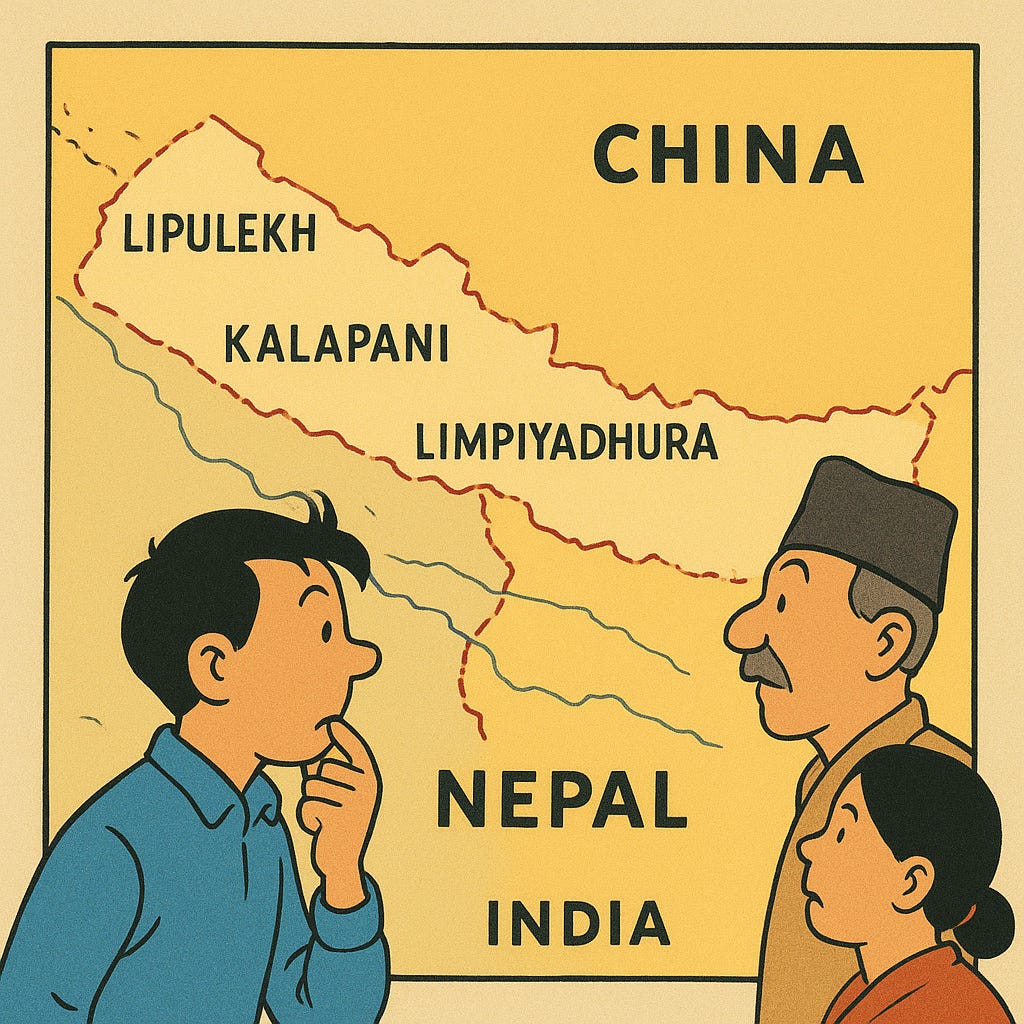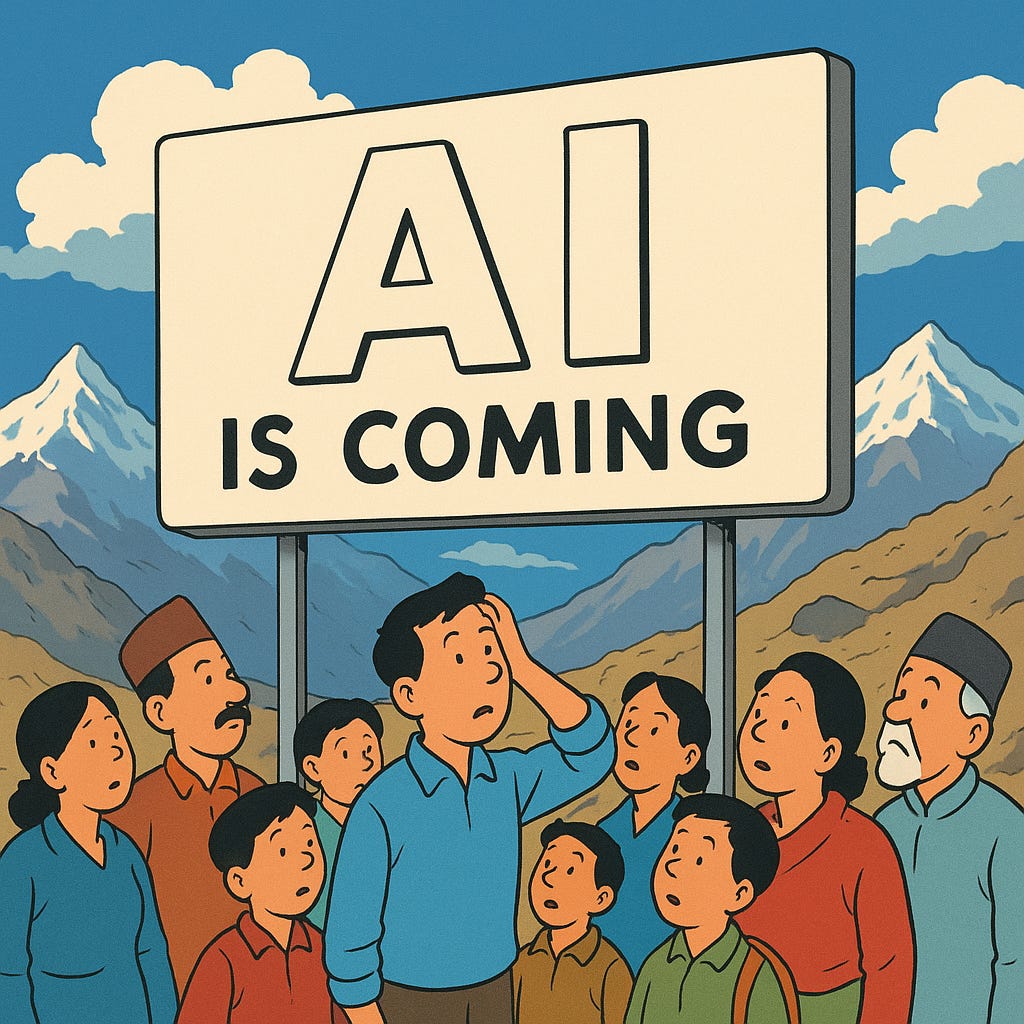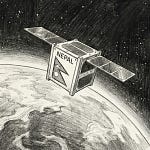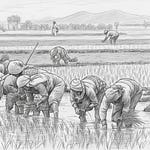Share the love! Help others that care about Nepal stay up to date the easy way. If you like this issue, share it with a friend who follows Nepal and hit Subscribe for your weekly dose of curated, can’t-miss updates.
A high‑stakes diplomatic row over Lipulekh–Kalapani–Limpiyadhura has put Nepalese sovereignty and regional strategy center stage as India and China press ahead with border trade and infrastructure agreements. At home, the government is racing to modernise—rolling out a National AI Policy, expanding fibre and partnering with TikTok to boost tourism—while urgent Valley water‑safety alerts and Saurav’s “Timetax” essay remind the diaspora of everyday realities that shape family life and livelihoods.
Featured Guest Essay: The Timetax: How Many Hours Does a Diaper Cost?
A short, urgent personal essay by Saurav that converts everyday prices into hours of life—showing how a pack of diapers costs just over an hour’s work in London but more than three full workdays in Kathmandu. It’s a powerful, human lens on migration, wages and the quiet tradeoffs families make for dignity and presence.
Read the full essay
Politics & Governance 🏛️
A fresh diplomatic row over Lipulekh–Kalapani–Limpiyadhura has pushed Nepal’s question of sovereignty back to the top of the agenda, after India and China moved to reopen trade through Lipulekh without Kathmandu’s involvement — a development that Nepal’s foreign ministry says contradicts historical treaties and its 2020 map and highlights how Kathmandu is often sidelined when the region’s giants negotiate Himalayan access and routes (MyRepublica). New Delhi’s quick rejection of Nepal’s claims and its framing of the issue as a bilateral matter with China have amplified domestic political pressure, feeding concerns that strategic infrastructure and pilgrimage routes are being decided without full regional consultation and weakening Nepal’s negotiating leverage on the ground.
Into that sensitive context steps Prime Minister KP Sharma Oli, who will attend the SCO summit in Tianjin and visit India in September to press for Nepal’s observer status and to manage high‑level diplomacy ahead of a tightly scheduled party policy convention; Beijing’s expectation of a prime‑ministerial delegation and the prospect of bilateral meetings with leaders such as Xi and Modi underscore both the opportunity and the tight choreography required (KTM Post). Domestically, Oli must also navigate party tensions and public sentiment that view any perceived concession on border matters as politically costly, so the trip is as much about restoring Nepal’s regional voice as it is about securing tangible diplomatic wins.
At home and in parallel, practical diplomacy is underway: Indian Foreign Secretary Vikram Misri’s two‑day Kathmandu visit signalled close pre‑visit coordination on connectivity and the agenda for Oli’s India trip, while bilateral expert talks on the Tarai drinking‑water crisis — including on‑site inspections and a prior MoU with India’s Jal Shakti ministry — point to areas of development cooperation that can yield immediate relief and build goodwill if translated into a concrete agreement during upcoming engagements (KTM Post, THT). Together, these strands — territorial diplomacy, summit‑level outreach and on‑the‑ground development work — will shape public perceptions of Kathmandu’s effectiveness in protecting national interests and delivering for communities, especially in the drought‑hit Tarai.
Economy & Development 💸
Top of the economy docket is the Nepal Electricity Authority’s fiscal squeeze: a near 37% fall in profit amid lower export rates, rising operating costs and significant foreign‑exchange losses, even as revenue from electricity sales climbed and domestic consumption grew—an outcome that complicates Nepal’s ambition to scale up exports and finish major transmission projects (RisingNepal, MyRepublica). The NEA is still pushing big targets—new interconnectors with India and China, pumped‑storage planning and smart‑meter rollouts—but the short‑term picture calls for tighter cost control, currency hedging and clearer frameworks to attract private investment for generation and transmission.
Our secondary pick is the digital‑infrastructure push as the Nepal Telecommunications Authority and NTC sign a three‑year, Rs 2 billion deal to lay roughly 1,900 km of optical fibre across Gandaki and Lumbini—covering 23 districts and 194 local levels—as part of the government’s Digital Nepal ambitions (THT). If delivered on time, this project could unlock broadband access for schools, health posts and small businesses, reduce urban–rural connectivity gaps and create a platform for digital services that boost jobs and local entrepreneurship.
Other notable developments to watch: the stalled promise of Gautam Buddha International Airport in Bhairahawa remains a local economic crisis—debt, empty terminals and calls for private operators risk dampening Lumbini’s tourism potential (KTM Post); the Nepal Tourism Board’s MoU with TikTok signals a modern push to convert short‑form storytelling into arrivals and rural incomes (THT); and shifting on‑the‑ground tourism models (Sauraha’s move from elephant rides to ethical “bush walks”) plus persistent structural unemployment underline that boosting jobs requires coordinated policy on skills, regional investment and sustainable tourism to turn headline projects into real livelihoods (KTM Post, MyRepublica).
Social & Cultural ⭐
The government’s approval of the National AI Policy marks a pivotal cultural and economic moment: it lays out an institutional architecture—an AI Regulation Council and a National AI Centre—along with standards for data, ethics and a roadmap for skills, research and data‑centre development that could reshape how Nepalis learn, work and create (THT, KTM Post). If implemented well, the policy can democratise tools for teachers, health workers, artists and local entrepreneurs; if it stalls, it risks widening a digital divide where urban tech firms capture gains while rural communities lag. Practical hurdles—broadband and 5G rollout, clear tax and investment signals, and hands‑on training from schools to universities—will determine whether AI becomes a tool for cultural expression and jobs or another source of displacement. The policy’s emphasis on periodic review, ethical safeguards and public‑private partnerships is promising, but the next 12–24 months will be decisive for turning promises into local impact.
Water safety in the Valley has become a daily cultural concern after tests found hazardous faecal coliform in a significant share of tap and some jar water samples, prompting official advisories to boil water and urgent calls for regular testing and supplier enforcement (KTM Post). Beyond immediate health risks—dysentery, typhoid and cholera—contaminated water disrupts family routines, school attendance and festival life, and erodes trust in municipal services; bottled water’s own quality issues deepen that anxiety. Short‑term responses (boil notices, sealing unsafe suppliers) must be paired with long‑term fixes: sewage control, pipeline repairs, and community‑led monitoring. Framing water as a shared cultural asset, not only an engineering problem, will help mobilise neighbourhood groups, faith organisations and schools to protect public health and social life during the monsoon and beyond.
Other cultural shifts are unfolding in parallel: Google’s nationwide Street View rollout opens new ways for the diaspora and travellers to explore Nepal’s streets and heritage online, a quiet boost for storytelling and trip planning that can feed local tourism narratives (MyRepublica). At the same time, the Supreme Court’s ruling that social‑media and online platforms must register raises sharp questions about balancing misinformation control with press freedom and civic debate—the decision touches journalists, creators and how communities verify facts in a fast‑moving online culture (KTM Post). Tensions in education have also spilled into public life, with private schools planning protests over the School Education Bill, a sign that debates over access, scholarships and school governance are reshaping parental expectations and classroom culture (MyRepublica). Together these stories show a society negotiating tech, trust and institutions—the cultural work now is to make these transitions inclusive, transparent and anchored in community needs.
Diaspora & Globalisation
At least 10 Nepalis dead and dozens more hospitalised in Kuwait after consuming methanol-tainted alcohol, with the Nepali embassy coordinating care and outreach to affected workers while urging vigilance against illicit substances (KTM Post). Embassy teams are working with Kuwaiti health authorities to confirm identities, assist families and ensure treatment for those in intensive care.
The family of hostage Bipin Joshi has pressed for his release during visits and meetings in Israel as Nepal steps up diplomatic channels and appeals to mediators; the case has drawn public attention and official reassurances without endorsing broader military actions (THT, MyRepublica). Nepali officials say they are prioritising quiet, sustained negotiation and consular support to secure his safe release.
Both stories underscore the need for stronger worker protections abroad and sustained diplomatic support from Kathmandu as families and communities await timely updates and practical assistance.
Let’s connect
Enjoying this issue? 📩 Share it with a friend & let’s keep Nepalis worldwide in the loop! Got thoughts? Hit reply—we’re all ears! Or let us know what you think via our Feedback form or follow us on Facebook | LinkedIn
P.S. Got a story or issue you'd like us to cover next week? Drop us a reply — we're building this space together.
About Nepali Diaspora Digest:
The Nepali Diaspora Digest connects the global Nepali community with curated news, insights, and stories that matter most. Join us as we celebrate and explore the diverse voices and achievements of Nepalis worldwide.
Partner shout out
belayat.uk: helping Nepalis connect in the UK on jobs, housing, events and finding local Nepali owned businesses















